Dark Matter Searches at LNF
Abstract
1. Introduction
2. The Frascati National Laboratory
- DANE, an e e collider, unique in Europe, operated at energy and able to deliver instantaneous luminosities cm s.
- DANE-light, a synchrotron light laboratory, housing several synchrotron radiation lines extracted from the electron ring of DANE in the soft-X and infrared range.
- a Beam Test Facility, BTF, an experimental area equipped for detector and beam diagnostic tests. Here, two beam lines, extracted from the DANE LINAC, can provide beams of electrons, positrons, photons of variable intensity and energy [11].
- SPARC_LAB, a complex hosting a photo-injector that can produce high brightness electron beams up to 170 MeV (SPARC), which feeds a 12-m long undulator for FEL generation and a laser (FLAME) of power ∼200 TW. The SPARC_LAB is an infrastructure for R&D on new techniques of particle acceleration and for interdisciplinary studies, including PWFA and LWFA experiments, TeraHertz radiation and a Compton source [12].
3. The Problem of Dark Matter
4. Search for the QCD Axion
4.1. The QUAX Experiment at LNF
4.2. From KLASH to FLASH search for Axions with a Large Volume Haloscope
5. Dark Photon Search
5.1. The PADME Experiment
5.2. The PADME Detector
- a high intensity and low divergence positron beam, impinging on a thin, active target, capable of monitoring the beam size and intensity (maximum energy 550 MeV);
- a vacuum vessel to avoid spurious particle interactions;
- a dipole magnet to deflect the beam of positrons emerging from the target, with the additional task of enabling the measurement of the momentum of the interacting positrons, thus, allowing the rejection of the Bremsstrahlung background; and
- a finely-segmented, high-resolution e.m. calorimeter, to measure the momentum of the single SM photons (ECal) [71].
- A fast Small Angle Calorimeter (SAC), placed behind the central hole of the ECal. This is used to detect and veto backgrounds photons (mainly from Bremsstrahlung) [72].
- Three stations of plastic scintillator fingers, located inside the vacuum chamber, two within the dipole magnet gap ( veto and veto), and the third one on the beam exit (high energy veto), to veto charged particles produced in the interaction [73].
5.3. Dark Sector Search with PADME
5.4. Improvements of the Positron Beam
- Further extending the primary positron beam accelerated by the LINAC: due to the sharp shape of the compressed RF pulse needed for reaching higher energies, this is generally achieved at the cost of a reduced maximum energy. A beam length in the s range can be achieved, having, as a reference, minimum energy the kinematic threshold for the production of the hypothetical 17 MeV boson postulated for accounting the anomalies in the Be and He IPC transitions, of ≈300 MeV [78].
- Much longer positron beams, in the ms range, with the same particle density can be achieved by using one of the DANE main rings, or in the case of the smaller accumulator ring, as an extender of the LINAC beam pulses (POSEYDON project) [79]. The standard technique is exciting a betatron tune resonance (typically close to a third of integer) to increase the oscillations of the circulating positrons and drive them toward an extraction septum.
- The resonant extraction can be improved by using the deflection of positrons due to coherent processes in bent crystal, like the channeling, volume reflection or mirroring effects (SHERPA project) [80].
- A possible continuous beam extraction can be obtained profiting of the transverse offset of particles due to an energy loss mechanism: positrons can be scattered by intra-beam elastic interactions (the so-called Touschek effect), or by a thin target (wire) intercepting the beam periphery, or by the photons of a suitable laser beam (inverse Compton effect). Eventually, those stray particles will be further deflected by means of conventional septum magnet.
- The not-attenuated LINAC pulse, extended to ≈300 ns, produces a high intensity electron (or positron) beam, which can be used for performing a thick target experiment in the area of the existing DANE LINAC dump.
6. Conclusions
Author Contributions
Funding
Institutional Review Board Statement
Informed Consent Statement
Data Availability Statement
Conflicts of Interest
References
- Alesini, D.; Anania, M.P.; Artioli, M.; Bacci, A.; Bartocci, S.; Bedogni, R.; Bellaveglia, M.; Biagioni, A.; Bisesto, F.; Brandi, F.; et al. EuPRAXIA@SPARC_LAB Conceptual Design Report. 2018. Available online: http://www.lnf.infn.it/sis/preprint/pdf/getfile.php?filename=INFN-18-03-LNF.pdf (accessed on 7 July 2021).
- Assmann, R.W.; Weikum, M.K.; Akhter, T.; Alesini, D.; Alexandrova, A.S.; Anania, M.P.; Andreev, N.E.; Andriyash, I.; Artioli, M.; Aschikhin, A.; et al. EuPRAXIA Conceptual Design Report. Eur. Phys. J. ST 2020, 229, 3675–4284, Erratum in 2020, 229, 11–31. [Google Scholar] [CrossRef]
- Bernardini, C.; Bizzarri, U.; Corazza, G.F.; Ghigo, G.; Querzoli, R.; Touschek, B. A 250-Mev Electron-Positron Storage Ring: The ”A D A”. In Proceedings of the 3rd International Conference on High-Energy Accelerators, HEACC 1961, Upton, NY, USA, 6–12 September 1961; pp. 256–261. [Google Scholar]
- Amman, F.; Andreani, R.; Bassetti, M.; Bernardini, M.; Cattoni, A.; Chimenti, V.; Corazza, G.F.; Dehne, H.C.; Fabiani, D.; Massarotti, A.; et al. Single and two beam operation in adone. In Proceedings of the 7th International Conference on High-Energy Accelerators, HEACC 1969, Yerevan, USSR, 27 August–2 September 1969; pp. 9–18. [Google Scholar]
- Zobov, M. DAFNE status and upgrade plans. Phys. Part. Nucl. Lett. 2008, 5, 560–565. [Google Scholar] [CrossRef][Green Version]
- Bloise, C. Hadron physics with KLOE data at the ϕ-factory. AIP Conf. Proc. 2020, 2249, 020004. [Google Scholar] [CrossRef]
- Anastasi, A.; Babusci, D.; Bencivenni, G.; Berlowski, M.; Bloise, C.; Bossi, F.; Branchini, P.; Budano, A.; Balkeståhl, L.C.; Cao, B.; et al. Measurement of the running of the fine structure constant below 1 GeV with the KLOE Detector. Phys. Lett. B 2017, 767, 485–492. [Google Scholar] [CrossRef]
- Zmeskal, J.; Beer, G.; Bragadirean, A.M.; Cargnelli, M.; Curceanu, C.; Egger, J.P.; Fuhrmann, H.; Guaraldo, C.; Iliescu, M.; Ishiwatari, T.; et al. The DEAR experiment: First results on kaonic hydrogen. Nucl. Phys. A 2005, 754, 369–374. [Google Scholar] [CrossRef][Green Version]
- Bazzi, M.; Beer, G.; Bombelli, L.; Bragadireanu, A.M.; Cargnelli, M.; Corradi, G.; Curceanu, C.; d’Uffizi, A.; Fiorini, C.; Frizzi, T.; et al. First measurement of kaonic helium-3 X-rays. Phys. Lett. B 2011, 697, 199–202. [Google Scholar] [CrossRef]
- Agnello, M.; Benussi, L.; Bertani, M.; Bhang, H.C.; Bonomi, G.; Botta, E.; Bregant, M.; Bressani, T.; Bufalino, S.; Busso, L.; et al. Hypernuclear spectroscopy with K− at rest on 7Li, 9Be, 13C and 16O. Phys. Lett. B 2011, 698, 219–225. [Google Scholar] [CrossRef]
- Valente, P.; Belli, M.; Bolli, B.; Buonomo, B.; Cantarella, S.; Ceccarelli, R.; Cecchinelli, A.; Cerafogli, O.; Clementi, R.; Di Giulio, C.; et al. Linear Accelerator Test Facility at LNF: Conceptual Design Report. arXiv 2016, arXiv:1603.05651. [Google Scholar]
- Ferrario, M.; Alesini, D.; Anania, M.; Bacci, A.; Bellaveglia, M.; Bogdanov, O.; Boni, R.; Castellano, M.; Chiadroni, E.; Cianchi, A.; et al. SPARC_LAB present and future. Nucl. Instrum. Meth. B 2013, 309, 183–188. [Google Scholar] [CrossRef]
- Bahcall, N.A.; Ostriker, J.P.; Perlmutter, S.; Steinhardt, P.J. The Cosmic triangle: Assessing the state of the universe. Science 1999, 284, 1481–1488. [Google Scholar] [CrossRef]
- Spergel, D.N.; Steinhardt, P.J. Observational evidence for selfinteracting cold dark matter. Phys. Rev. Lett. 2000, 84, 3760–3763. [Google Scholar] [CrossRef]
- Battaglieri, M.; Belloni, A.; Chou, A.; Cushman, P.; Echenard, B.; Essig, R.; Estrada, J.; Feng, J.L.; Flaugher, B.; Fox, P.J.; et al. US Cosmic Visions: New Ideas in Dark Matter 2017: Community Report. arXiv 2017, arXiv:1707.04591. [Google Scholar]
- Jungman, G.; Kamionkowski, M.; Griest, K. Supersymmetric dark matter. Phys. Rep. 1996, 267, 195–373. [Google Scholar] [CrossRef]
- Preskill, J.; Wise, M.B.; Wilczek, F. Cosmology of the Invisible Axion. Phys. Lett. B 1983, 120, 127–132. [Google Scholar] [CrossRef]
- Peccei, R.D.; Quinn, H.R. Constraints Imposed by CP Conservation in the Presence of Instantons. Phys. Rev. D 1977, 16, 1791–1797. [Google Scholar] [CrossRef]
- Arcadi, G.; Dutra, M.; Ghosh, P.; Lindner, M.; Mambrini, Y.; Pierre, M.; Profumo, S.; Queiroz, F.S. The waning of the WIMP? A review of models, searches, and constraints. Eur. Phys. J. C 2018, 78, 203. [Google Scholar] [CrossRef]
- Essig, R.; Jaros, J.A.; Wester, W. Dark Sectors and New, Light, Weakly-Coupled Particles. arXiv 2013, arXiv:1311.0029. [Google Scholar]
- Alexander, J.; Battaglieri, M.; Echenard, B.; Essig, R.; Graham, M.; Izaguirre, E.; Jaros, J.; Krnjaic, G.; Mardon, J.; Morrissey, D.; et al. Dark Sectors 2016 Workshop: Community Report. arXiv 2016, arXiv:1608.08632. [Google Scholar]
- Weinberg, S. A New Light Boson? Phys. Rev. Lett. 1978, 40, 223–226. [Google Scholar] [CrossRef]
- Wilczek, F. Problem of Strong P and T Invariance in the Presence of Instantons. Phys. Rev. Lett. 1978, 40, 279–282. [Google Scholar] [CrossRef]
- Peccei, R.D.; Quinn, H.R. CP Conservation in the Presence of Pseudoparticles. Phys. Rev. Lett. 1977, 38, 1440–1443. [Google Scholar] [CrossRef]
- Abbott, L.; Sikivie, P. A cosmological bound on the invisible axion. Phys. Lett. B 1983, 120, 133–136. [Google Scholar] [CrossRef]
- Dine, M.; Fischler, W. The not-so-harmless axion. Phys. Lett. B 1983, 120, 137–141. [Google Scholar] [CrossRef]
- Ipser, J.; Sikivie, P. Can galactic halos be made of Axions? Phys. Rev. Lett. 1983, 50, 12. [Google Scholar] [CrossRef]
- Sikivie, P. Experimental Tests of the “Invisible” Axion. Phys. Rev. Lett. 1983, 51, 1415–1417. [Google Scholar] [CrossRef]
- Sikivie, P. Detection rates for “invisible”-axion searches. Phys. Rev. D 1985, 32, 2988–2991. [Google Scholar] [CrossRef] [PubMed]
- Alesini, D.; Braggio, C.; Carugno, G.; Crescini, N.; D’Agostino, D.; Di Gioacchino, D.; Di Vora, R.; Falferi, P.; Gambardella, U.; Gatti, C.; et al. Search for Invisible Axion Dark Matter of mass ma = 43 μeV with the QUAX-aγ Experiment. arXiv 2020, arXiv:2012.09498. [Google Scholar]
- Du, N.; Force, N.; Khatiwada, R.; Lentz, E.; Ottens, R.; Rosenberg, L.J.; Rybka, G.; Carosi, G.; Woollett, N.; Bowring, D.; et al. Search for invisible axion dark matter with the axion dark matter experiment. Phys. Rev. Lett. 2018, 120, 151301. [Google Scholar] [CrossRef]
- Braine, T.; Cervantes, R.; Crisosto, N.; Du, N.; Kimes, S.; Rosenberg, L.J.; Rybka, G.; Yang, J.; Bowring, D.; Chou, A.S.; et al. Extended search for the invisible axion with the axion dark matter experiment. Phys. Rev. Lett. 2020, 124, 101303. [Google Scholar] [CrossRef]
- Zhong, L.; Al Kenany, S.; Backes, K.M.; Brubaker, B.M.; Cahn, S.B.; Carosi, G.; Gurevich, Y.V.; Kindel, W.F.; Lamoreaux, S.K.; Lehnert, K.W.; et al. Results from phase 1 of the HAYSTAC microwave cavity axion experiment. Phys. Rev. D 2018, 97, 092001. [Google Scholar] [CrossRef]
- Backes, K.M.; Palken, D.A.; Al Kenany, S.; Brubaker, B.M.; Cahn, S.B.; Droster, A.; Hilton, G.C.; Ghosh, S.; Jackson, H.; Lamoreaux, S.K.; et al. A quantum-enhanced search for dark matter axions. Nature 2021, 590, 238. [Google Scholar] [CrossRef]
- McAllister, B.T.; Flower, G.; Ivanov, E.N.; Goryachev, M.; Bourhill, J.; Tobar, M.E. The ORGAN experiment: An axion haloscope above 15 GHz. Phys. Dark Universe 2017, 18, 67–72. [Google Scholar] [CrossRef]
- Jeong, J.; Bae, S.; Semertzidis, Y.K.; Youn, S.; Kim, J.; Seong, T.; Kim, J.E. Search for invisible axion dark matter with a multiple-cell haloscope. Phys. Rev. Lett. 2020, 125, 221302. [Google Scholar] [CrossRef]
- Choi, J.; Lee, S.; Ahn, S.; Ko, B.R.; Semertzidis, Y.K. Axion Dark Matter Search around 6.7 μeV. Phys. Rev. Lett. 2020, 124, 101802. [Google Scholar] [CrossRef]
- Melcón, A.Á.; Cuendis, S.A.; Cogollos, C.; Díaz-Morcillo, A.; Döbrich, B.; Gallego, J.D.; Gimeno, B.; Irastorza, I.G.; Lozano-Guerrero, A.J.; Malbrunot, C.; et al. Axion searches with microwave filters: The RADES project. J. Cosmol. Astropart. Phys. 2018, 2018, 040. [Google Scholar] [CrossRef]
- Crescini, N.; Alesini, D.; Braggio, C.; Carugno, G.; D’Agostino, D.; Di Gioacchino, D.; Falferi, P.; Gambardella, U.; Gatti, C.; Iannone, G.; et al. Axion Search with a Quantum-Limited Ferromagnetic Haloscope. Phys. Rev. Lett. 2020, 124, 171801. [Google Scholar] [CrossRef]
- Alesini, D.; Babusci, D.; Björkeroth, F.; Bossi, F.; Ciambrone, P.; Monache, G.D.; Di Gioacchino, D.; Falferi, P.; Gallo, A.; Gatti, C.; et al. KLASH Conceptual Design Report. arXiv 2019, arXiv:1911.02427. [Google Scholar]
- Caldwell, A.; Dvali, G.; Majorovits, B.; Millar, A.; Raffelt, G.; Redondo, J.; Reimann, O.; Simon, F.; Steffen, F.; MADMAX Working Group. Dielectric Haloscopes: A New Way to Detect Axion Dark Matter. Phys. Rev. Lett. 2017, 118, 091801. [Google Scholar] [CrossRef]
- BRASS: Broadband Radiometric Axion SearcheS. Available online: http://wwwiexp.desy.de/groups/astroparticle/brass/brassweb.htm (accessed on 7 July 2021).
- Ouellet, J.L.; Salemi, C.P.; Foster, J.W.; Henning, R.; Bogorad, Z.; Conrad, J.M.; Formaggio, J.A.; Kahn, Y.; Minervini, J.; Radovinsky, A.; et al. First Results from ABRACADABRA-10 cm: A Search for Sub-μeV Axion Dark Matter. Phys. Rev. Lett. 2019, 122, 121802. [Google Scholar] [CrossRef]
- Aybas, D.; Adam, J.; Blumenthal, E.; Gramolin, A.V.; Johnson, D.; Kleyheeg, A.; Afach, S.; Blanchard, J.W.; Centers, G.P.; Garcon, A.; et al. Search for Axionlike Dark Matter Using Solid-State Nuclear Magnetic Resonance. Phys. Rev. Lett. 2021, 126, 141802. [Google Scholar] [CrossRef]
- Barbieri, R.; Braggio, C.; Carugno, G.; Gallo, C.; Lombardi, A.; Ortolan, A.; Pengo, R.; Ruoso, G.; Speake, C. Searching for galactic axions through magnetized media: The QUAX proposal. Phys. Dark Universe 2017, 15, 135–141. [Google Scholar] [CrossRef]
- Crescini, N.; Alesini, D.; Braggio, C.; Carugno, G.; Di Gioacchino, D.; Gallo, C.S.; Gambardella, U.; Gatti, C.; Iannone, G.; Lamanna, G.; et al. Operation of a ferromagnetic axion haloscope at ma = 58 μeV. Eur. Phys. J. C 2018, 78. [Google Scholar] [CrossRef]
- Alesini, D.; Braggio, C.; Carugno, G.; Crescini, N.; D’Agostino, D.; Di Gioacchino, D.; Di Vora, R.; Falferi, P.; Gallo, S.; Gambardella, U.; et al. Galactic axions search with a superconducting resonant cavity. Phys. Rev. D 2019, 99, 101101. [Google Scholar] [CrossRef]
- Di Gioacchino, D.; Gatti, C.; Alesini, D.; Ligi, C.; Tocci, S.; Rettaroli, A.; Carugno, G.; Crescini, N.; Ruoso, G.; Braggio, C.; et al. Microwave Losses in a DC Magnetic Field in Superconducting Cavities for Axion Studies. IEEE Trans. Appl. Supercon. 2019, 29, 1–5. [Google Scholar] [CrossRef]
- Alesini, D.; Braggio, C.; Carugno, G.; Crescini, N.; D’Agostino, D.; Di Gioacchino, D.; Di Vora, R.; Falferi, P.; Gambardella, U.; Gatti, C.; et al. High quality factor photonic cavity for dark matter axion searches. Rev. Sci. Instrum. 2020, 91, 094701. [Google Scholar] [CrossRef] [PubMed]
- Alesini, D.; Braggio, C.; Carugno, G.; Crescini, N.; D’ Agostino, D.; Di Gioacchino, D.; Di Vora, R.; Falferi, P.; Gambardella, U.; Gatti, C.; et al. Realization of a high quality factor resonator with hollow dielectric cylinders for axion searches. Nucl. Instrum. Methods A 2021, 985, 164641. [Google Scholar] [CrossRef]
- COLD Lab. Available online: http://coldlab.lnf.infn.it (accessed on 7 July 2021).
- Zorin, A.B. Josephson Traveling-Wave Parametric Amplifier with Three-Wave Mixing. Phys. Rev. Appl. 2016, 6, 034006. [Google Scholar] [CrossRef]
- Heinsoo, J.; Andersen, C.K.; Remm, A.; Krinner, S.; Walter, T.; Salathé, Y.; Gasparinetti, S.; Besse, J.C.; Potočnik, A.; Wallraff, A.; et al. Rapid High-fidelity Multiplexed Readout of Superconducting Qubits. Phys. Rev. Appl. 2018, 10, 034040. [Google Scholar] [CrossRef]
- Ahn, D.; Kwon, O.; Chung, W.; Jang, W.; Lee, D.; Lee, J.; Youn, S.W.; Youm, D.; Semertzidis, Y.K. Superconducting cavity in a high magnetic field. arXiv 2020, arXiv:2002.08769. [Google Scholar]
- Alesini, D.; Babusci, D.; Barone, C.; Buonomo, B.; Beretta, M.M.; Bianchini, L.; Castellano, G.; Chiarello, F.; Gioacchino, D.D.; Falferi, P.; et al. Development of a Josephson junction based single photon microwave detector for axion detection experiments. J. Phys. Conf. Ser. 2020, 1559, 012020. [Google Scholar] [CrossRef]
- Alesini, D.; Babusci, D.; Barone, C.; Buonomo, B.; Beretta, M.M.; Bianchini, L.; Castellano, G.; Chiarello, F.; Di Gioacchino, D.; Falferi, P.; et al. Status of the SIMP Project: Toward the Single Microwave Photon Detection. J. Low Temp. Phys. 2020, 199, 348–354. [Google Scholar] [CrossRef]
- Piedjou Komnang, A.S.; Guarcello, C.; Barone, C.; Gatti, C.; Pagano, S.; Pierro, V.; Rettaroli, A.; Filatrella, G. Analysis of Josephson junctions switching time distributions for the detection of single microwave photons. Chaos Solitons Fractals 2021, 142, 110496. [Google Scholar] [CrossRef]
- Paolucci, F.; Buccheri, V.; Germanese, G.; Ligato, N.; Paoletti, R.; Signorelli, G.; Bitossi, M.; Spagnolo, P.; Falferi, P.; Rajteri, M.; et al. Development of highly sensitive nanoscale transition edge sensors for gigahertz astronomy and dark matter search. J. Appl. Phys. 2020, 128, 194502. [Google Scholar] [CrossRef]
- SUPERGALAX H2020-FETOPEN-2018-2019-2020-01. Available online: https://supergalax.eu (accessed on 7 July 2021).
- Kuzmin, L.S.; Sobolev, A.S.; Gatti, C.; Di Gioacchino, D.; Crescini, N.; Gordeeva, A.; Il’ichev, E. Single Photon Counter based on a Josephson Junction at 14 GHz for searching Galactic Axions. IEEE Trans. Appl. Supercond. 2018, 28, 2400505. [Google Scholar] [CrossRef]
- Franzini, P.; Moulson, M. The Physics of DAΦNE and KLOE. Annu. Rev. Nucl. Part. Sci. 2006, 56, 207–251. [Google Scholar] [CrossRef]
- Abi, B.; Acciarri, R.; Acero, M.A.; Adamov, G.; Adams, D.; Adinolfi, M.; Ahmad, Z.; Ahmed, J.; Alion, T.; Monsalve, S.A.; et al. Experiment Simulation Configurations Approximating DUNE TDR. arXiv 2021, arXiv:2103.04797. [Google Scholar]
- Bertani, M.; Cecchetti, A.; Dulach, B.; Fabbri, F.L.; Giardoni, M.; Lanaro, A.; Lucherini, V.; Bressani, T.; Feliciello, A.; Filippi, A.; et al. The FINUDA superconducting magnet at DAFNE. Nucl. Phys. B Proc. Suppl. 1999, 78, 553–558. [Google Scholar] [CrossRef]
- Berezhiani, Z.G.; Dolgov, A.D.; Mohapatra, R.N. Asymmetric inflationary reheating and the nature of mirror universe. Phys. Lett. B 1996, 375, 26–36. [Google Scholar] [CrossRef]
- Holdom, B. Searching for ϵ Charges and a New U(1). Phys. Lett. B 1986, 178, 65–70. [Google Scholar] [CrossRef]
- Lee, H.S. Muon g−2 anomaly and dark leptonic gauge boson. Phys. Rev. D 2014, 90, 091702. [Google Scholar] [CrossRef]
- Pospelov, M. Secluded U(1) below the weak scale. Phys. Rev. D 2009, 80, 095002. [Google Scholar] [CrossRef]
- Nardi, E.; Carvajal, C.D.R.; Ghoshal, A.; Meloni, D.; Raggi, M. Resonant production of dark photons in positron beam dump experiments. Phys. Rev. D 2018, 97, 095004. [Google Scholar] [CrossRef]
- Krasznahorkay, A.J.; Csatlós, M.; Csige, L.; Gácsi, Z.; Gulyás, J.; Hunyadi, M.; Kuti, I.; Nyakó, B.M.; Stuhl, L.; Timár, J.; et al. Observation of Anomalous Internal Pair Creation in Be8: A Possible Indication of a Light, Neutral Boson. Phys. Rev. Lett. 2016, 116, 042501. [Google Scholar] [CrossRef] [PubMed]
- Raggi, M.; Kozhuharov, V. Proposal to Search for a Dark Photon in Positron on Target Collisions at DAΦNE Linac. Adv. High Energy Phys. 2014, 2014, 959802. [Google Scholar] [CrossRef]
- Albicocco, P.; Alexander, J.; Bossi, F.; Branchini, P.; Buonomo, B.; Capoccia, C.; Capitolo, E.; Chiodini, G.; Caricato, A.P.; de Sangro, R.; et al. Characterisation and performance of the PADME electromagnetic calorimeter. JINST 2020, 15, T10003. [Google Scholar] [CrossRef]
- Frankenthal, A.; Alexander, J.; Buonomo, B.; Capitolo, E.; Capoccia, C.; Cesarotti, C.; De Sangro, R.; Di Giulio, C.; Ferrarotto, F.; Foggetta, L.; et al. Characterization and performance of PADME’s Cherenkov-based small-angle calorimeter. Nucl. Instrum. Meth. A 2019, 919, 89–97. [Google Scholar] [CrossRef]
- Oliva, F. The charged particle veto system of the PADME experiment. Nucl. Instrum. Meth. A 2019, 936, 259–260. [Google Scholar] [CrossRef]
- Available online: http://www.caen.it (accessed on 7 July 2021).
- Darmé, L.; Giacchino, F.; Nardi, E.; Raggi, M. Invisible decays of axion-like particles: Constraints and prospects. arXiv 2020, arXiv:hep-ph/2012.07894. [Google Scholar]
- Ciafaloni, P.; Martelli, G.; Raggi, M. Searching for dark sectors in multi lepton final states in e+e− collisions. JHEP 2021, 04, 163. [Google Scholar] [CrossRef]
- Valente, P.; Belli, M.; Buonomo, B.; Ceccarelli, R.; Cecchinelli, A.; Clementi, R.; Di Giulio, C.; Foggetta, L.G.; Piermarini, G.; Rossi, L.A.; et al. Long beam pulses with SLED compression in DAΦNE LINAC. J. Phys. Conf. Ser. 2017, 874, 012017. [Google Scholar] [CrossRef]
- Valente, P. Ideas for extending the Frascati LINAC positron beam pulses for the resonant search of a X(17 MeV) boson. arXiv 2020, arXiv:2001.10258. [Google Scholar]
- Valente, P. POSEYDON-Converting the DAΦNE Collider into a double Positron Facility: A High Duty-Cycle pulse stretcher and a storage ring. arXiv 2017, arXiv:1711.06877. [Google Scholar]
- Garattini, M.; Gianotti, P.; Guiducci, S.; Liedl, A.; Vaccarezza, C. The SHERPA Experiment. LNF-Activity Report-2020. 2021. Available online: http://www.lnf.infn.it/rapatt/2020/sherpa.pdf (accessed on 7 July 2021).
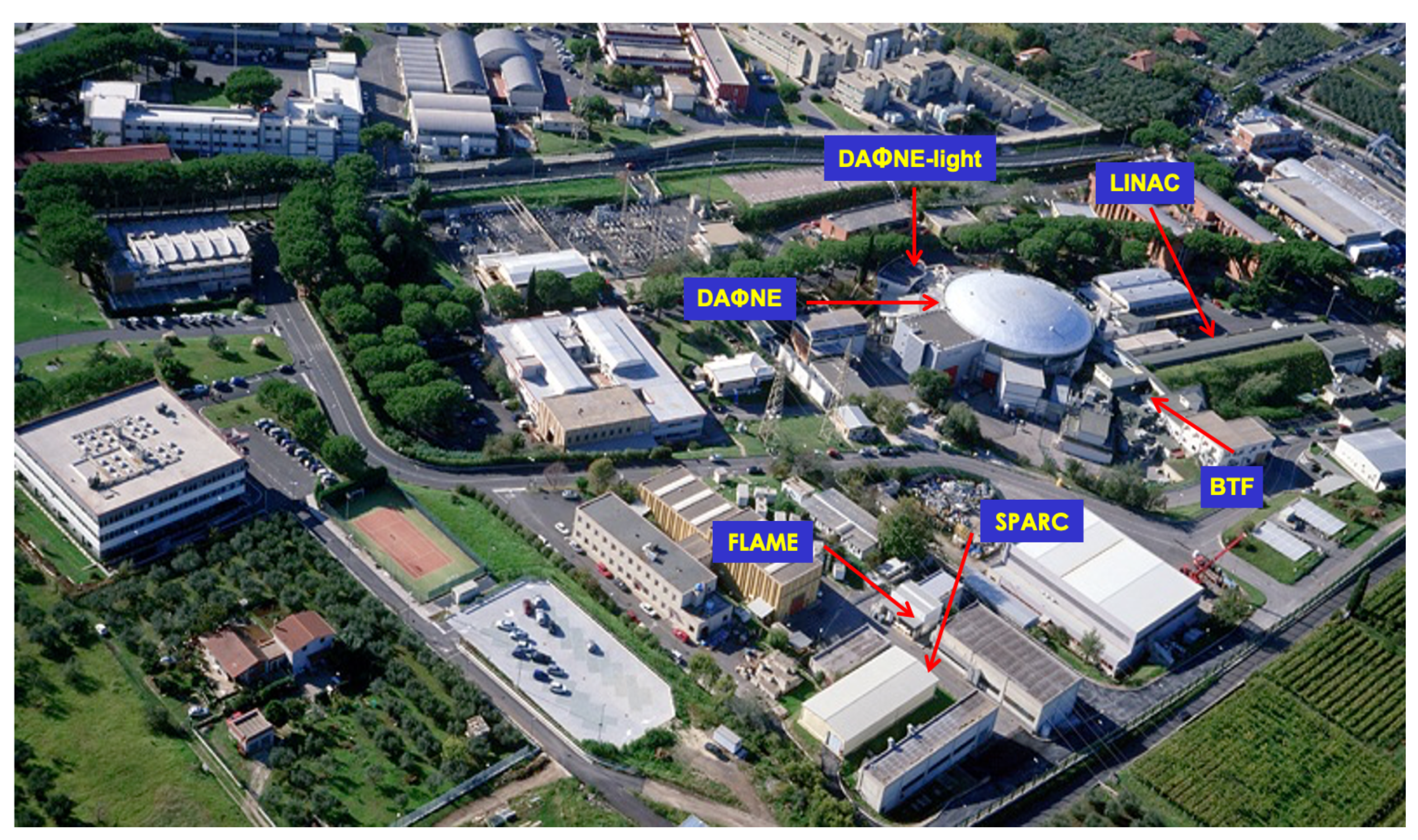
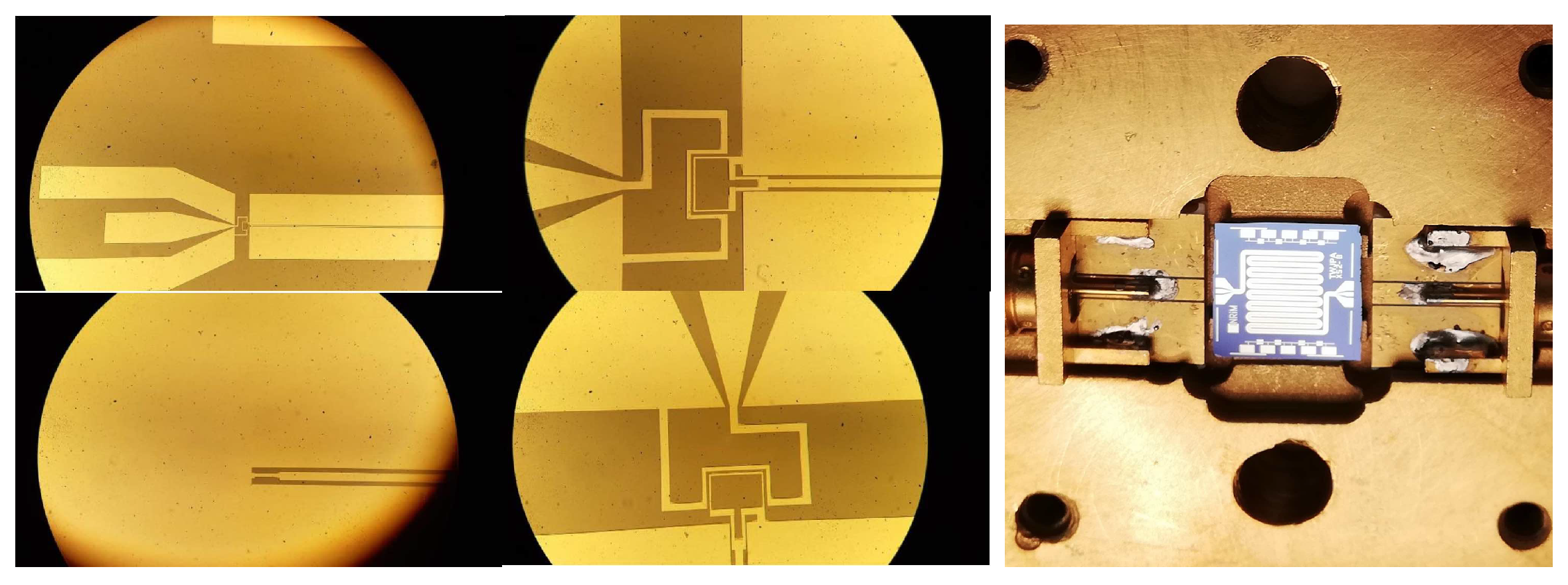
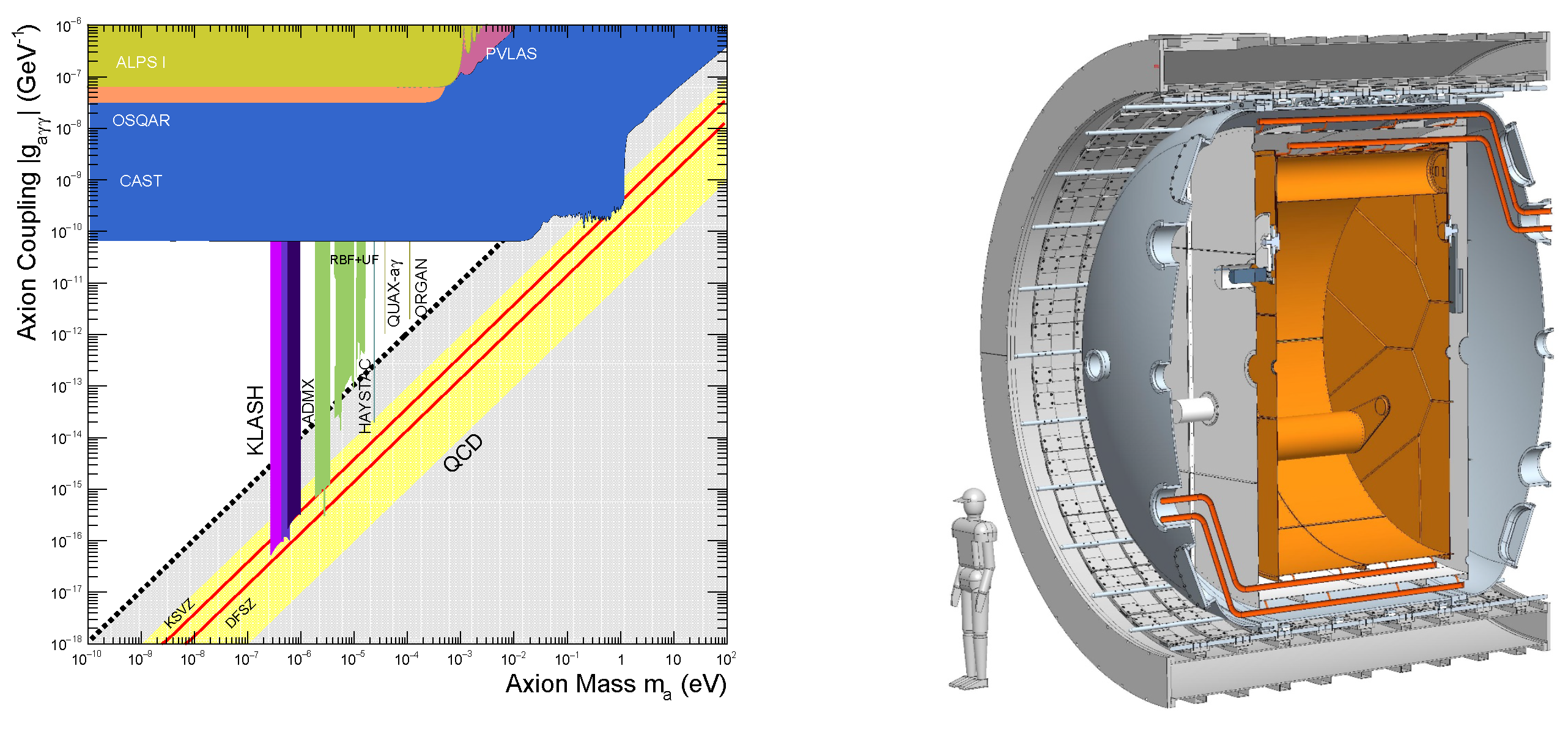
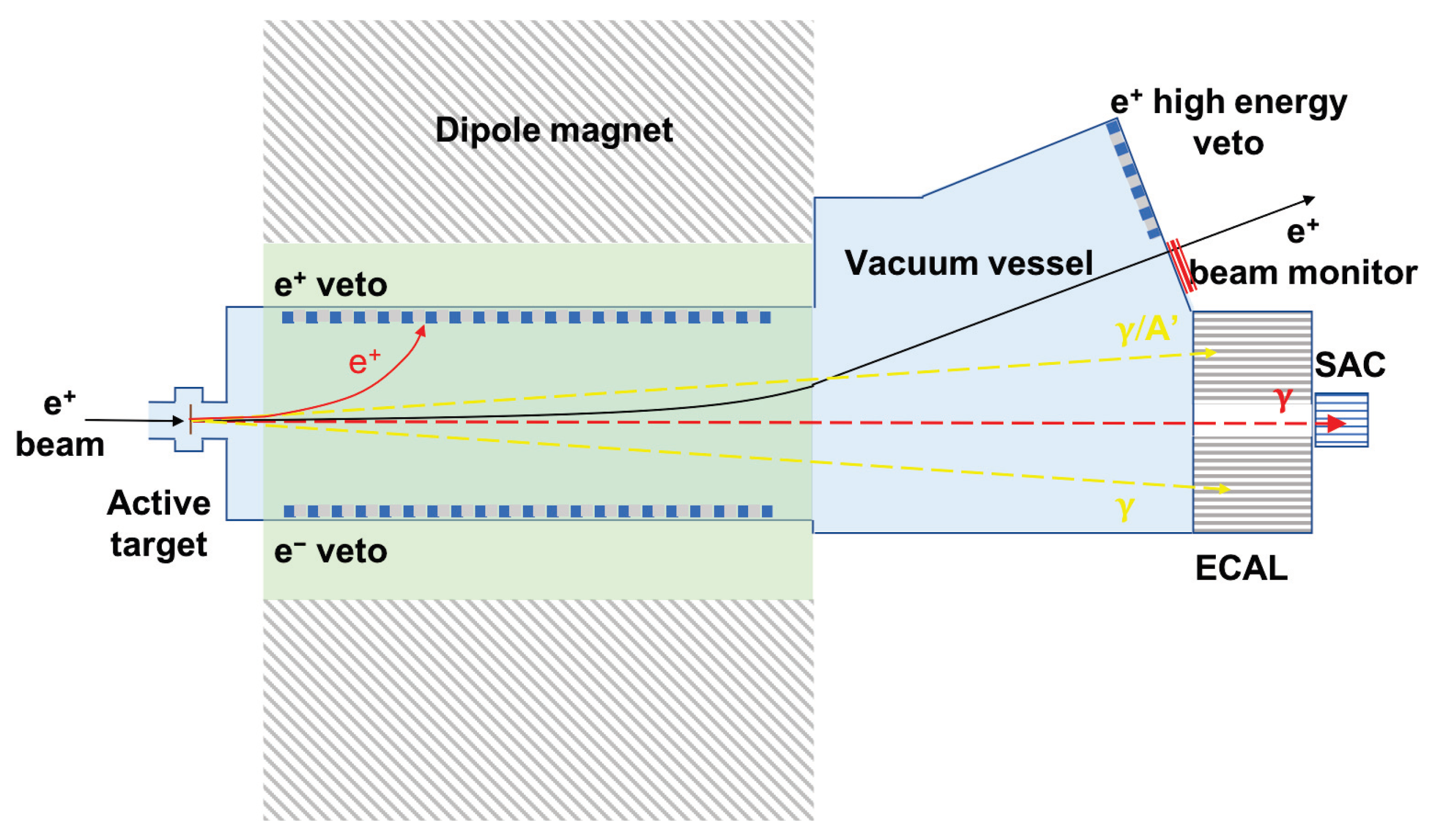
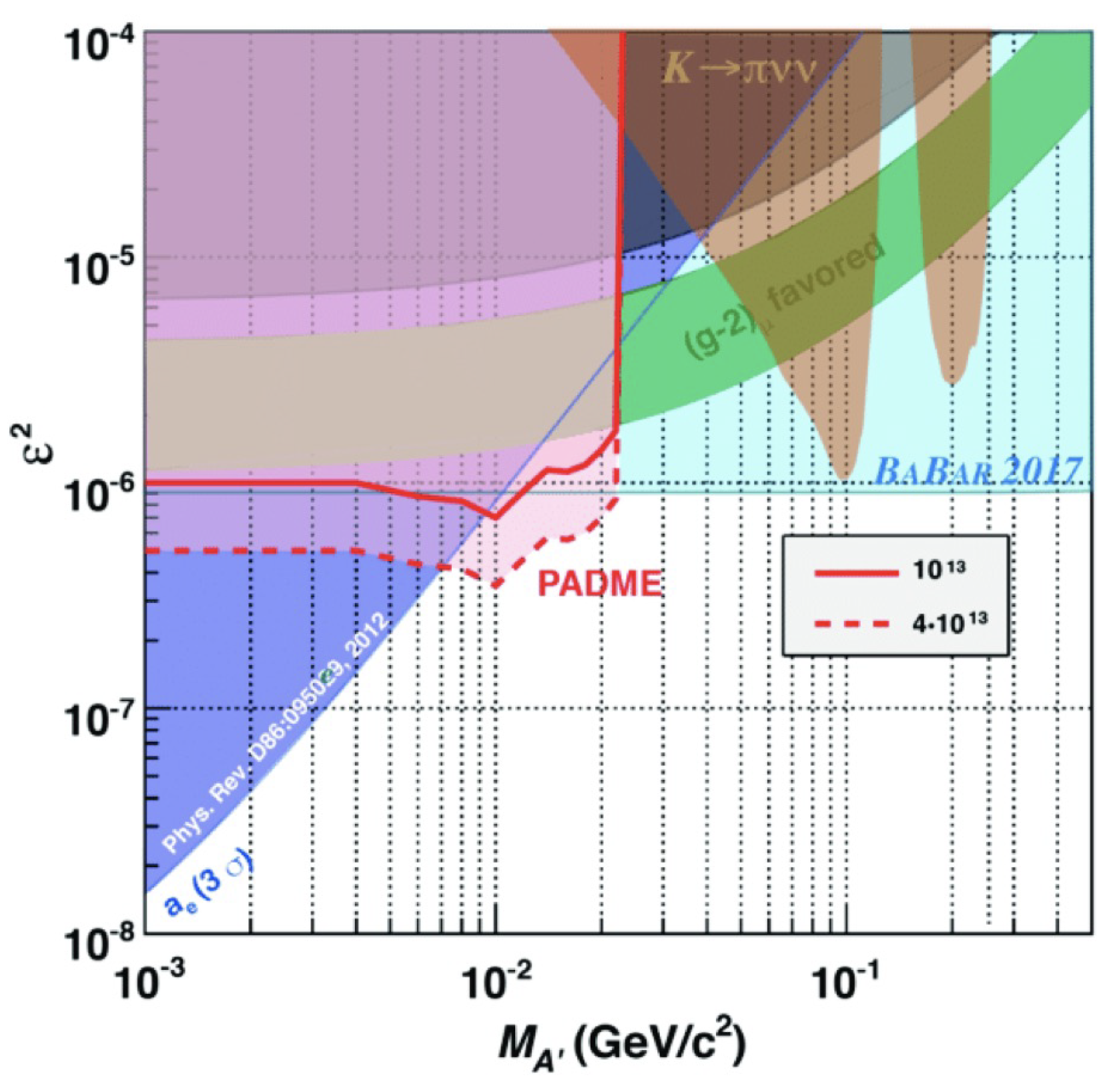
| Parameter | Value |
|---|---|
| [eV] | 0.27 |
| [GeV] | |
| [W] | |
| Rate [Hz] | 3050 |
| [T] | 0.6 |
| 2 | |
| [min] | 5 |
| [K] | 4.9 |
| 90% c.l. [GeV] |
| Process | [mb] |
|---|---|
| 1.55 | |
| 4000 | |
| 0.16 |
| Primary | Secondary | |
|---|---|---|
| Pulse length | 150–320 ns | |
| Maximum energy | 490 MeV | 545 MeV |
| Maximum intensity | ||
Publisher’s Note: MDPI stays neutral with regard to jurisdictional claims in published maps and institutional affiliations. |
© 2021 by the authors. Licensee MDPI, Basel, Switzerland. This article is an open access article distributed under the terms and conditions of the Creative Commons Attribution (CC BY) license (https://creativecommons.org/licenses/by/4.0/).
Share and Cite
Gatti, C.; Gianotti, P.; Ligi, C.; Raggi, M.; Valente, P. Dark Matter Searches at LNF. Universe 2021, 7, 236. https://doi.org/10.3390/universe7070236
Gatti C, Gianotti P, Ligi C, Raggi M, Valente P. Dark Matter Searches at LNF. Universe. 2021; 7(7):236. https://doi.org/10.3390/universe7070236
Chicago/Turabian StyleGatti, Claudio, Paola Gianotti, Carlo Ligi, Mauro Raggi, and Paolo Valente. 2021. "Dark Matter Searches at LNF" Universe 7, no. 7: 236. https://doi.org/10.3390/universe7070236
APA StyleGatti, C., Gianotti, P., Ligi, C., Raggi, M., & Valente, P. (2021). Dark Matter Searches at LNF. Universe, 7(7), 236. https://doi.org/10.3390/universe7070236







